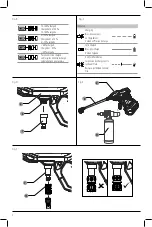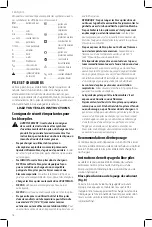
11
English
Pressure Washing
Preparing Surface for Cleaning
• Remove objects from the area which could create
a hazard.
• Ensure that all doors and windows are closed tight. Protect
all plants and trees in the adjacent area with a drop cloth
ensuring that they will not be harmed by any overspray.
• Pre‑rinse cleaning area with fresh water.
• Use only detergents formulated for pressure washers.
• Always test detergent in an inconspicuous area before use.
Speed Selector (Fig. A, K)
This power cleaner gives you the choice to operate at a lower
pressure for more delicate jobs, or accelerate the power
cleaner speed for high‑performance cleaning.
To accelerate,
pull the speed selector
19
back toward the
main handle
1
into the "HI" position. This mode is best for
applications that need higher PSI.
For lower pressure
, push the speed selector forward
toward the spray wand
8
into the "LO" position. This mode
is best for larger projects that require more time to complete.
nOTE:
When in "HI" mode, runtime will be decreased as
compared to when pressure cleaner is in "LO" mode.
Proper hand position requires one hand on the main
handle
1
and the other hand on the power cleaner's
2
body as shown.
Proper Hand Position (Fig. J)
WARNING:
To reduce the risk of serious personal injury,
ALWAYS
use proper hand position as shown.
WARNING:
To reduce the risk of serious personal
injury,
ALWAYS
hold securely in anticipation of a
sudden reaction.
appropriate nozzle. Release the quick connect collar to lock
the nozzle in place.
To ensure nozzle is locked into place, give the nozzle a firm
tug after the quick connect collar has locked into place.
nOTE:
The multi‑spray nozzle is supplied with this
power cleaner, other nozzles are available, refer to the
Accessories
section.
How to Use the Multi‑Spray Nozzle
There are five spray pattern settings located on the
Multi‑Spray nozzle. To select a spray pattern, rotate the
spray selector to the desired setting. DO NOT change spray
patterns with the power cleaner powered on. Refer to the
following chart to choose the correct nozzle for the job to
be performed.
Nozzle
Uses
Surfaces*
Powerful pinpoint for
spot cleaning of hard,
unpainted surfaces or for
high reach areas
Unpainted metal or
concrete. DO NOT use
on wood
Intense cleaning of
unpainted hard surfaces
Grills, driveways, concrete
or brick walkways,
unpainted brick or stucco
Standard cleaning nozzle
for most applications
Yard tools, sidewalks, lawn
furniture, unpainted siding,
stucco, gutters and eaves,
concrete, brick surfaces
Cleaning of painted or
delicate surfaces
Auto/RV, marine, wood,
painted brick and stucco,
vinyl, painted siding
Low pressure setting for
most watering needs
Low pressure spray is safe
for all surfaces
*NOTICE:
The high pressure spray from your power
cleaner is capable of causing damage to surfaces such
as wood, glass, automobile paint, auto striping and
trim, and delicate objects such as flowers and shrubs.
Before spraying, check the item to be cleaned to assure
yourself that it is strong enough to resist damage from
the force of the spray.
Installing and Removing the Battery Pack
(Fig. I)
nOTE:
For best results, make sure your battery pack is
fully charged.
To Install the Battery Packs
1. Lift and hold the battery port cover
5
up to expose the
battery port.
2. Align the battery pack with the rails inside the tool’s
handle and slide it into the handle until the battery pack
is firmly seated in the tool and ensure that it does not
disengage.
3. Close the battery port cover
5
. Ensure the cover is fully
latched into position before starting tool.
To Remove the Battery Pack
1. Lift and hold the battery port cover
5
up to expose the
battery pack
17
.
2. Press the battery release button
18
on the battery
pack
17
and firmly pull the battery pack
17
out of tool.
3. Insert the battery into the charger as described in the
charger section of this manual.
OPERATION
WARNING: To reduce the risk of serious personal
injury, turn unit off and remove the battery pack
before making any adjustments or removing/
installing attachments or accessories.
An
accidental start‑up can cause injury.














































